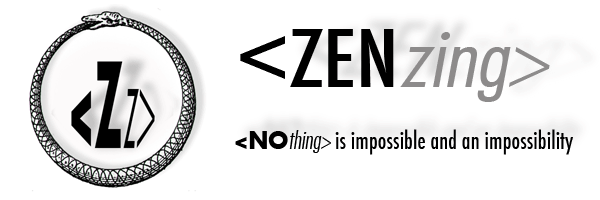Friday, August 19, 2016
Monday, January 12, 2015
Sunday, November 23, 2014
Thursday, April 30, 2009
Saturday, January 17, 2009
Saturday, January 3, 2009
[ZENzing] AND ANGST

In [ZENzing] angst is an issue that often needs to be confronted and dealt with. The feeling of dread that one often needs to deal with is at once plausible and palpable.
When confronting, let’s say dysfunction of any kind, there is a [zingMETHOD] available to deal with it. The [zing11ANGSTscale] is an element of this.
By giving [THEangst] a number and a descriptor it has been found that it then has worth. Firstly it needs to be understood that while this might appear to give a value to [THEangst] in the end it largely remains the same. It’s subjectivity, and transience, is simply expressed.
The exemplars here are entirely subjective and are not intended to be definitive. The [zingMETHOD] acknowledges that all things are as divisible as they are whole. This is as true of 1 as is it is of 11. Thus 1 has as much worth as 11 given that both are whole.
Together the descriptor and number ascribes worth to angst. Often a number alone is enough.
Wednesday, December 31, 2008
Notes on [ZENzing]

[ZENzing] is to do with positioning the multilayering and compounding the transience of ideas as a cultural or bureaucratic construct.
On one hand it is to do with syntactical dissidence (wrongness?), on another to do with eccentric vernacularizm (placedness?), on another there is ambiguity, on another it is reminiscent of imprecision and the ephemeral (openness cum fleetingness cum slipperyness?), on another there is visual signaling and on yet another there is an alertness to the mono no aware (Wabi-sabi). It is illustrative more than programmed.
In as much as the •ZEN• component may invoke a particular belief system at the same time it is more phonic and visual than caught up with anything related to wisdom. Likewise, the •zing•
Adherence to [ZENzing] is intuitive rather than learned. Consequently, adherents do not proselytize, as a [ZENzinger] will always be spontaneously self aware of their status.
Zenzing is a town in Germany (49° 11' 0" North, 12° 26' 0" East) – put that idea to one side. [ZENzing] is not a religion - refute that idea. [ZENzing] is not a movement - ignore that thought. [ZENzing] is a method; a conundrum; an utterly different attitude. It is [NOthing]; it is synonymous with [NOthingness]. [NOthingness] is now and never. [NOthing] is impossible and an impossibility.
11 [ZENzing] Protocols

In order to denote the compounding of the transience of an idea the ephemerality of the construct must be:
1. Indicated by bracketing the compounding with angle brackets or chevrons. However, in situations where digital language does not permit this (as is the case here), the [ZENzing] construct may be enclosed between two red bullets – • REDbullets • OR alternatively between [SQUAREbrackets]
2. Denoted by the first word/idea being bolded and CAPITALISED
3. Specified by the follow on word/idea being italicized and lowercase
4. In the case of [zingNESS], this is denoted by zing always being the first element, lowercase and italicized followed by the second being CAPITALIZED and bolded
5. In the case of
6. Denoting the plural where appropriate by the appropriate element(?) having a X> added to signify the plural is infinite and if the plural finite a X> followed by the finite number of the plural – X11> – this device is sometimes used to evaluate the plural via the [11scale];
7. In the case of the
8. Indicated by red brackets [ 1 ] where there is an element of inequality implied or conscious negative discrimination
9. Denoting genderization where appropriate with an additional > angle bracket after the closing bracket for male; a + after the closing bracket for female; or = after the closing bracket for neutral – >>, >+, >=
10. Indicating deliberate offense, if required, with a bolded double forward slash after the closing bracket – >//
11. Indicating jest with a bolded colon and curved bracket after the closing bracket – >:)
Subscribe to:
Posts (Atom)










